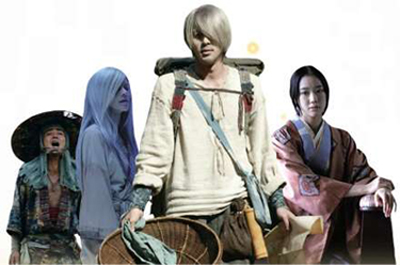Last week saw the English language DVD release of Bugmaster, Katsuhiro Otomo’s live-action adaptation of Yuki Urushibara’s supernatural manga series, Mushishi. The film is clumsy but fascinating. Otomo, who should be no stranger to anime and manga fans, does an admirable job of making the fantastic real and placing it squarely into the lives of the film’s characters.
Invisible creatures, called mushi, exist and flutter all around us. The word roughly translates as “bug”, and those who study and treat problems arising from mushi are known as mushishi. These men and women live as itinerant physicians/alchemists, and as is often the case with those who know too much, mushishi usually lead tragic and ill-fated lives.
Joe Odagiri plays Ginko, the one-eyed, pigmentless mushishi of the series. He’s almost too charming in the role, but he never stretches the viewer’s sense of the plausible. The film shares the same episodic style as the manga. The period is a slightly speculative Japanese setting, possibly late 19th century, but unfixed in definite time and place. Ginko encounters mushi that resemble a barnacle infestation, except these sprout a wormlike ectoplasmic tendril and their presence may cause deafness and the ability to hear voices. One mushi attracts another, and each has its counter or compliment in another. The supernatural elements become pseudoscientific. Ginko next encounters a man trying to capture a rainbow, and the two of them travel together. The pair stops to assist Tanyu, an old friend of Ginko’s. She’s able to transfer mushi onto paper as written words. Tanyu tells the pair of a blind mushishi named Nui who is linked somehow to Ginko. And that’s when things get confusing.
While there is a logic to the mushi throughout the film, it’s somewhat opaque. Otomo even goes so far as to edit out scenes that would provide exposition. However, as a visual artist Otomo knows how to make a simple scene of people walking look interesting. For much of the time, it’s this attention to the visual that holds one’s attention, and not so much the story itself. Not that the story is dull. There are moments of surprise and amazement in the film.
If anything, Mushishi resembles the pilot installment of a chambara series of films (a ghost-hunter Zatoichi as it were), except there’s never that big showdown at the end. There’s no final battle against some terrible scuttling beast with razor claws and long teeth. Instead there’s this puzzle of psychic biology, and the idea that mental problems might be the result of too many ectoplasmic snails stuck to the ceiling. Not necessarily a bad thing, but possibly a bit too inert for most people’s tastes. Which is too bad, because Mushishi is a fantasy film that’s worth seeing. It’s more eerie than scary, often haunting, and occasionally beautiful.
Justin Howe’s short fiction has appeared in or is forthcoming from Fast Ships, Black Sails, Beneath Ceaseless Skies, and Brain Harvest. Everything he knows about science fiction he learned from reading comics.










